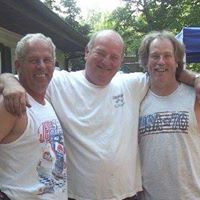Phillip M Fleming
age ~35
from Phillipsburg, NJ
Phillip Fleming Phones & Addresses
- Phillipsburg, NJ
- Frenchtown, NJ
- Bloomsbury, NJ
- Flemington, NJ
- Kohler, WI
License Records
Phillip Fleming
License #:
362 - Expired
Category:
Radiography
Issued Date:
Jan 28, 1998
Effective Date:
Dec 9, 2002
Expiration Date:
Jan 31, 2004
Type:
Limited Radiographer
Name / Title
Company / Classification
Phones & Addresses
ACME FE LLC
Resumes

Studying Computers.
view sourceLocation:
Westville, Florida
Industry:
Computer & Network Security
Work:
US Army Corps of Engineers 2008 - 2009
Combat Engineers
Combat Engineers
Interests:
Computer Support Technicians, new technologies, Space exploration.

Phillip Fleming
view source
Phillip Fleming
view source
Phillip Fleming
view source
Phillip Fleming
view source
Phillip Fleming
view source
Phillip Fleming
view source
Phillip Fleming
view sourceLocation:
United States
Us Patents
-
Method And Means For Adjusting A Forage Harvester Shear Bar Relative To A Rotating Chopping Cylinder
view source -
US Patent:44743360, Oct 2, 1984
-
Filed:Oct 21, 1982
-
Appl. No.:6/435565
-
Inventors:Phillip F. Fleming - West Bend WI
-
Assignee:Gehl Company - West Bend WI
-
International Classification:B02C 1816
-
US Classification:241221
-
Abstract:A method and means for adjusting a forage harvester shear bar relative to its rotating cylinder. The outer end of the shear bar, the central portion of the shear bar and the inner end of the shear bar can all be selectively adjusted while the cylinder is rotating, these adjustments being made from the outer or operator's side of the harvester and at a common location. All of the shear bar adjusting means are located at one convenient and safe area at the outer or operator's side of the machine and the operator can accurately adjust the outer, central or inner end of the bar by noting the "tick" noise created when the particular end or portion of the shear bar being adjusted touches or comes in contact with the rotating knife of the cylinder. This method and structure for permitting the operator to accurately adjust any portion of the shear bar while the cylinder is rotating and to make these adjustments without being endangered by the rotating cylinder results in adjustments which can be quickly and safely made.
-
Adjustable Cutter Bar Support
view source -
US Patent:40553094, Oct 25, 1977
-
Filed:Oct 12, 1976
-
Appl. No.:5/731121
-
Inventors:Phillip F. Fleming - West Bend WI
Steven J. Campbell - West Bend WI -
Assignee:Gehl Company - West Bend WI
-
International Classification:B02C 1816
-
US Classification:241221
-
Abstract:A support structure for a cutter bar for use in a forage harvester, the support structure adjustably supporting the opposite ends of the cutter bar and providing a convenient readily adjustable structure for supporting the central portion of the cutter bar to prevent movement of the central portion of the cutter bar relative to the cutting cylinder of the forage harvester and to afford adjustment of the position of the central portion of the cutter bar relative to the blades of the cutting cylinder.
-
Forage Harvester
view source -
US Patent:40335186, Jul 5, 1977
-
Filed:May 24, 1976
-
Appl. No.:5/689594
-
Inventors:Phillip F. Fleming - West Bend WI
Steven J. Campbell - West Bend WI -
Assignee:Gehl Company - West Bend WI
-
International Classification:B02C 1822
-
US Classification:241 47
-
Abstract:A forage harvester connectable to a vehicle such as a tractor for being towed by the tractor. The forage harvester includes a transmission having a horizontal rotatable input shaft and a horizontal output shaft separated by an angle of 100. degree. such that the input shaft can be positioned at an angle of approximately 10. degree. relative to the direction of motion of the forage harvester and generally co-axial or positioned at a small horizontal angle relative to the rotatable drive shaft extending from the tractor power take-off shaft to the input shaft. The forage harvester also includes a rotatable cutting cylinder and a blower for blowing out forage into a forage wagon towed by the forage harvester, the rotatable cutting cylinder and the blower being laterally spaced apart. The cutting cylinder and the blower are connected by a chute which functions to permit conveyance of the cut crop material to the blower, and a driven rotatable spinner is provided for propelling cut crop material from the cutting cylinder into the chute and toward the blower. The rotatable spinner is comprised of a circular disc, rotatably supported on a rotating drive shaft in closely spaced parallel relationship with respect to the bottom wall of the cut crop receiving housing.
-
Rotary Chopping Cylinder Type Forage Harvester Having Means For Sharpening Its Shear Bar
view source -
US Patent:43217737, Mar 30, 1982
-
Filed:Jun 30, 1980
-
Appl. No.:6/163984
-
Inventors:Phillip F. Fleming - West Bend WI
-
Assignee:Gehl Company - West Bend WI
-
International Classification:A01D 7508
B24B 342
B24B 1900 -
US Classification:51249
-
Abstract:A forage harvester for harvesting crops and reducing them to forage by means of a rotary chopping cylinder which has a plurality of blades around its periphery which cooperate with a shear bar carried on the frame of the harvester. A sharpening device is provided above the cylinder for sharpening the cylinder blades and brackets are also provided for mounting the shear bar when it is to be sharpened, above the cylinder so that the same sharpening device that is used to sharpen the blades of the cylinder can also be used to sharpen the shear bar. Bracket mounting structure is provided for the shear bar to ensure that it is sharpened at the proper angle.
Myspace
Classmates

Phillip Fleming
view sourceSchools:
Macon County High School Lafayette TN 1999-2003, Allen County-Scottsville High School Scottsville KY 2002-2003
Community:
Robert Stevenson

Phillip Fleming
view sourceSchools:
Riverside High School Riverside NJ 1997-2001
Community:
Melanie Sharkey, Kristin Sivon, Richard Yesner, Kristen Degarmo, S B, Ricky Hanks, Matthew Mann, Lisa Rossi, Mary Rambo

Phillip Fleming
view sourceSchools:
Alcester-Hudson High School Alcester SD 1991-1995
Community:
Lance Allen, Brooke Francis, Tiffany Joyce, Lance Joachim, Courtney Harvey, Wendell Steeneck, Bryan Blake, Kelly Beberniss, Christa Fickbohm, Bryan Bouthillier, Melissa Beeck

Phillip Fleming | Choctaw...
view source
Holmes County High School...
view sourceGraduates:
Phillip Fleming (1994-1998),
Joshua Mancill (1999-2003),
Annie Goodman (1973-1977),
David Marell (1984-1988)
Joshua Mancill (1999-2003),
Annie Goodman (1973-1977),
David Marell (1984-1988)

Choctawhatchee High Schoo...
view sourceGraduates:
Phillip Fleming (1961-1965),
Shannon Gunter (1993-1997),
Nora Bosnake (1978-1982),
Linda Crawley (1974-1978)
Shannon Gunter (1993-1997),
Nora Bosnake (1978-1982),
Linda Crawley (1974-1978)

Alcester-Hudson High Scho...
view sourceGraduates:
Phillip Fleming (1991-1995),
Ken Hansohm (1986-1990),
Lori Roskeland (1972-1976),
Kelly Reppe (1993-1997)
Ken Hansohm (1986-1990),
Lori Roskeland (1972-1976),
Kelly Reppe (1993-1997)

Phillip Drew Fleming
view source
Phillip Sly Fleming
view source
Phillip Fleming
view source
Phillip Feeyul Fleming
view source
Phillip Nathan Fleming
view source
Phillip Fleming
view source
Phillip Fleming Sr.
view source
Phillip L. Fleming
view sourceGoogleplus

Phillip Fleming
About:
I was born at Lyburn,Wv and raised at Dehue,Wv.

Phillip Fleming

Phillip Fleming

Phillip Fleming
Tagline:
Learn life

Phillip Fleming

Phillip Fleming

Phillip Fleming

Phillip Fleming
Youtube
Plaxo

Phillip Fleming
view sourceGet Report for Phillip M Fleming from Phillipsburg, NJ, age ~35










